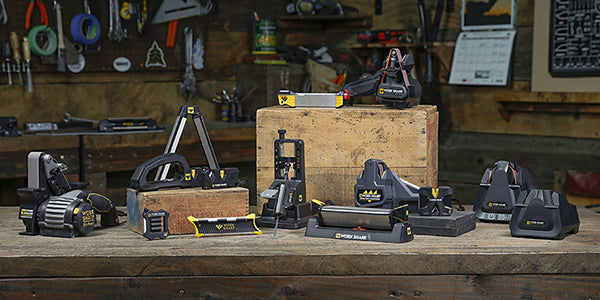
Trolling for Rainbow Trout in the Spring can bring some challenges due to dirty water from freshet, but you can still be successful and fill limits with the right approach. Expert Fisherman, Danny Coyne, shares his effective tactics, and it all starts with a sharp knife.
Top 5 Tactics for Trolling Rainbow Trout in Dirty Water
If you have ever tried to catch Rainbow Trout in murky water situations you know it can be challenging. However, these periods can also offer some of the greatest fishing opportunities of the year. As anglers we need to work extra hard to discover ways to increase the fish we catch in murky water conditions. Here’s our top 5 tactics for trolling Rainbow Trout in dirty water to help increase your odds the next time you are faced with these conditions.
Keep Those Hooks Sharp!
No matter which lure or fishing presentation I’m using when pursing trout, there is one important item I always consider - having a precision sharp hook. Even the most effective fishing lure is only as good as how sharp the hook is. When a trout takes a swipe at your lure it literally has a split second to get a good hook set so need to make it count. A lot of our lures rattle around in our tackle boxes, the boat gunnel, or have caught numerous amounts of fish that eventually dull the hook’s point. This is why I keep a Work Sharp Guided Field Sharpener nearby and religiously sharpen each of my lures before fishing with them. If the hook doesn’t easily scratch the back of your fingernail, it needs to be sharpened. Running the hook through the ceramic hook sharpener a couple times gives me the confidence for a solid hook set when the trout takes a strike.
Contrast & Fluorescent UV Colours
While fishing in stained water, paying attention to the color and contrast is very important. In fact, in my experience, it’s the time of year that changing your lures color can make the biggest difference. You need to think about contrast! There is a lack of light penetrating the water so using darker colors will create contrast and stand out much greater to the fish. Using attractors with brass and copper will out-produce regular silver or chrome 4 to 1 due to the low amount of light available for reflection. Using lures such as spoons with color combinations with brass, fluorescent, or glow can be lethal combinations. Fluorescent UV and glow colors will give that eye appeal to the fish, as these colors require less light to reflect the lures. I also find that UV orange and copper color of lures/attractors work very well during the spring periods as they reflect the UV properties along with creating strong contrast in the murky water. Choosing lures such as plugs or spoons that have dark or fluorescent spots on them will also stand out to a fish. In extremely milky water, using black dodgers or flashers with dark lures can payoff dividends!
Sound & Vibration
Rainbow Trout are the apex predator in majority of our fisheries. They are very good at homing in and attacking their prey. One of the ways they do this is by detecting the low frequency vibrations or movements by smaller prey fish by utilizing their lateral lines. Using lures that create a small vibration (sound) can help the trout locate your presentation from a fair distance, even during stained water conditions. Plugs that have small rattles in them have a tendency to out fish non-rattle lures such as spoons. Another great way to put off an attractive vibration is to use lures that have spinner blades such as a wedding ring or spinner hoochie. These blades put off small sonic vibrations that entice a trout to track down your gear and strike!
Using attractors will also really put the odds in your favour. Using dodgers, lake trolls or flashers are a huge benefit during dirty water conditions. Attractors create displacement in the water that help the trout find your presentation. During these low visibility periods you can up the size of attractors without spooking the fish like it can in clear water conditions.
Speeds
Your trolling speed needs to adjust to the conditions. Unlike in clear water when we troll a variety of speeds with pulses and intervals, I find it more productive to troll at a continuous speed. In murky water the trout have to work extra hard to locate your baits. By trolling at a constant speed the fish won’t give up as quickly when hunting down your gear. The key to this is that you need to find the productive speed that your lure’s action continues to work effectively and you start to get strikes. Once you start to connect with fish pay attention to your trolling speed and keep with it. It’s a fine balance from going too slow and too fast. Choosing lures such as a variety Mack’s Lure Smile Blade lures that work in slow trolling applications will aid you in this process.
Depth of Your Presentation
Before the freshet arrived you may have been hammering Rainbows in the deep-water regions of the lake. However, Rainbow’s behavior will change once the spring runoff starts to enter into the lake. The tributaries are not only bringing in warmer water, but they are depositing a ton of nutrients into the lake. These elements attract small forage fish into the shallow shoals. The warm water can also provide extra comfort for the trout. Rainbows that were once chasing baitfish on the surface over a couple hundred feet of water can now be residing near shallow shoals or ledges, feeding upon baitfish while being in comfortable water conditions. A lot of the times you will see a distinct divide within the water where the clean lake water meets the murky runoff water. These are excellent areas to target as the trout will tend to hang out in these zones. Troll just on the edge of the clean water in these areas.
Your lure depth while trolling is also extremely important to pay attention to. Unlike clear water conditions the fish’s strike zone is reduced during murky times.
If you are marking fish at 50 feet on your sonar and your gear is at 65 feet, you need to adjust your downrigger to the depth in which you are marking fish. This way you can be confident that your presentation is within the fish’s strike zone. During dirty water situations Rainbows tend not move quickly throughout the water column chasing forage but rather wait for an opportunistic meal to present itself. The cloudy water conditions aid predator fish like the Rainbow Trout in providing them an advantage in ambushing their prey.
Surface Fish
Usually on bright spring days, the sun will push the fish down within the water column as it’s harder on their eyes as well as they will follow their food. When the water clarity diminishes, the Rainbows are more apt to stay near the surface because the murky water provides a filter-like effect from the bright light. This can be a very good time to surface fish for Rainbows no matter if you have bright or cloudy days. As noted above, the trout tend to use the low water clarity to ambush their prey. By trolling your lures on the surface it’s delivers a silhouette effect to your lure making for an easy target. Running dark colored plugs that have erratic vibrating action is an excellent option for this method.
Check out more fishing advice from Pro Staffer Danny Coyne here.





